|
The thriving curiosity with electricity in the late 1700's to early 1800's
resulted in many unique devices, ranging from simple electrostatic
generators to unique applications of electricity such as medical machines
and perpetual motion. Below are a few examples of these devices:
|
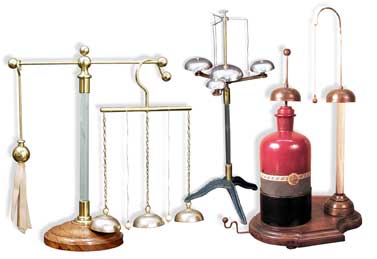 Electrostatic Bells
Electrostatic Bells
18th and 19th Century |
Franklin's Bells
During one of his many experiments around the middle
of the 18th century, Benjamin Franklin noticed that a pith ball or cork
would initially be attracted to a charged object, but if the two touched
the ball would be repelled. He realized that this was because the
two objects were initially charged differently (dissimilar charges
attract) but once they touched they took on the same charge (similar
charges repel).
Franklin realized that if he
replaced the charged object with a bell, he could make an "electric
bell." He soon found practical use for his bell as a lightning
detector. When connected it to his lightning rod, the bell would
ring whenever an electrical storm was nearby.
Apparently he forgot to disconnect
the bells during one of his many trips to France and his wife was quite
unhappy with him!
|
Electrical Orrery 1850 - 1860

Representations of the sun, earth and moon in painted
wood and bone. All three are
balanced on two brass wires and rotate when exposed to static
electricity from static generator. This electro-static philosophical
accessory is pictured in Benjamin Pike's 1848 Catalog Vol I. fig
316, pg 282; also pictured and described in numerous Natural
Philosophy books and other trade catalogs of the period; pictured
and described in the King George III Collection as well. American
made |

Hand-held Sparkling Tube
Likely French
mid 19th century
|

Electrical Aurora Tube
Likely American
1840's
Used to create spark and light effect
with electro-static generator.

Scintillating Glass Globe
Italian
1820's
With a silver
dotted foil spiral conductor which carries electrostatic sparks
continuously down the spiral in a dazzling display.
|
|
|

Scintillating
Spiral Tube
English
1850's |

Sprial
Tube
American
1850 |

Spiral Tube Array
1870
Popular
electrostatic accessories where a dramatic electric display would be
created if a static charge were applied to the brass ball finial
atop the hand-blown glass tube, the charge would spiral down the
path of tin foil disks leading down the tube(s).
|
|
 Dancing Images
-
1840's Dancing Images
-
1840's
From the objects in the collection constructed by J.M.
Wightman. See pg 216 of Select Experiments in Natural Philosophy by
Joseph M. Wightman and illustrated in his 1842 and 1858 trade
catalogs as well. Made of walnut and has an adjustable metallic
plate. Images of pith or paper figures are put between the plates,
and the top plate is connected to the conductor of an electrostatic
machine; the images will then begin to "dance" around. Missing top
plate. American |
|
Dancing
Figures Apparatus - 1st Qtr, 19th Century

Little figures of pith or
paper are meant to be cut out and laid on the lower brass plate; the
top brass terminal is connected to an electrostatic machine and the
pith/paper figures begin to dance and jump as they carry the charge
back and forth between the plates. French, 1st quarter of the
Nineteenth Century. |
|

Volta "Multi-Pistol"
Six Volta cannons arranged on a spinning
disk. The cannons fire in sequence as each cannon's electrode
touches the static machine. |
|

Volta Cannon |
|

Air Cannon
c. 1900
|
|
Very
Early Voltas Cannister - 1820's

The elegant flask shape is 5" at
it's highest point. Provenance, design, and detailing of brass
suggest that this objects dates from the first quarter of the
Nineteenth Century and was very likely contemporary with Allessandro
Volta. Italian, Very fine condition. Circa 1820's |
Electrostatic
Weapons?
In 1777 Allesandro Volta was
interested in the characteristics of swamp gases. In order to test
flammability he invented his cannon (see below). He would collect swamp
gas then fill his pistol with it. The cork on top would be put in after
the pistol was filled, to keep the gas from escaping. There would be a
metal rod tipped with a brass ball in the cork at the bottom which would
serve as a spark plug.
If the gas were flammable, and the proportions right, it
would explode when sparked. Volta's early pistols were capable of
sending a lead ball twenty feet, and denting a board.18
Long after its scientific use had gone, the Volta Pistol
remained a favorite lecture-hall demonstration.
These devices was
hardly practical as weapons and certainly not nearly as effective as
gunpowder weapons which were common at the time.

Volta Cannon
C. 1860
Angelo Arrighini
Italy
|

Volta Pistol |
|

Early Volta Cannon
1787 |
 |
|
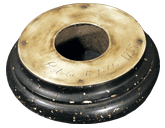
Inscribed cannon base
"Pistola du Volta 1787" |
|
Group of Volta Canisters - Late 19th Century
 From right to left: 1 Volta Canister with Bullseye made of
polychromed andvariously painted tin, cork glass and brass; measures
7-1/2" high and bullseye circle is 3-1/2" diameter; 2) Volta's
Canister made of above materials, measures 4-1/4" in height; 3)
Philosophical Instrument made of same painted tin and multi-colored
striped barrel which fits into the main tin container. Unknown what
this device was used to demonstrate but likely hydrostatics;
measures 7-1/2" in height. French or German, late
19th century.
|
|
Electrical Egg Stand -
1840

Consists of wooden frame and three
wooden stands to hold as many eggs. A wire and brass ball pass
through the upper part of the frame so as to touch the top egg. A
piece of metal lays on the bottom of the frame, touching the bottom
egg. As an electrical shock is passed on the upper brass ball, the
eggs will become beautifully luminous. Apparatus is made of
mahogany, whose base is 5" x 3" and is 7-5/8" in height. Described
and illustrated in Pike's Catalog Vol. I page 293, figure 340. Fine
condition. Likely English circa 1840. |
|
Electrical Sportsmen - Last Qtr, 18th Century
 Three figures (left to
right) made of hand painted tin with lead weights in base measuring
5-1/4", 5-1/4" and 6-3/8" high. They are beautifully painted, noting
considerable loss of original paint. See pg. 283, fig 318 of Pike's
Catalog Vol I. French; likely last quarter of the 18th Century. Three figures (left to
right) made of hand painted tin with lead weights in base measuring
5-1/4", 5-1/4" and 6-3/8" high. They are beautifully painted, noting
considerable loss of original paint. See pg. 283, fig 318 of Pike's
Catalog Vol I. French; likely last quarter of the 18th Century. |
|
|
|
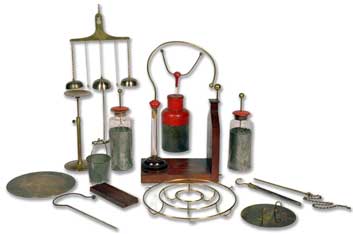 Box
Containing Electrostatic Philosophical Apparatus - 1st Qtr, 19th
Century Box
Containing Electrostatic Philosophical Apparatus - 1st Qtr, 19th
Century
Includes: 1) Thunder House made of
mahogany, brass, cork and glass. Measures 7-3/8" x 4-3/8 at base and
wooden house is 9-1/4" high including brass ball at top of house;
glass pillar is 6-3/4" high. Same apparatus as described and
illustrated in Public and Private Science: The King George III
Collection on page 515, figure E202 and in Benjamin Pike's Catalog
Vol. I page 309, figure 369 2) Electrical Bells made of brass.
Measures 9" in width from one outer bell to the other. See page
272-273, figure 296 in Pike's Catalog. When exposed to the static
electricity of an electrostatic generator these bells give a
continuous sublime chime. 3) Set of three Leyden Jars measuring 6",
6" and 6-1/2" high; see pg 260, fig 276 Pike's Catalog; 4)
Electrical Pail made of tin, 2-3/8" diameter at top. See pg. 285,
fig. 322 Pike's Catalog; 5) Electrical Flyer measures 8" diameter.
Made of brass. See Pike's Catalog pg. 280, fig. 313. All the above
are in fine condition and contained in a green painted wooden box
(in various compartments) measuring 12-14/" x 10-1/4" x 93/4"
English, first quarter 19th Century. |
|
Cylinder for Dancing Pith Balls - 1840
Made of mahogany, boxwood, brass, metal foil and glass. When the
prime conductor is connected to an electrical charge, the pith balls
placed in the cylinder will dance up and down carrying the
electricity from the upper to the lower plate. Mahogany base
measures 3" in diameter and the apparatus is 8-7/8" at highest
point. See Pike's Catalog Vol. I pg. 277, fig. 303 Fine condition.
English, Circa 1840.
|

Electrostatic Induction
Apparatus
French
1830's |
|
Glass-legged Stool
- 1884

Used in
early electrical experiments and electro-therapy to insulate the subject
from a path to electrical ground.
|
|
Pair of Insulating Stools - 1st Qtr 19th Century

Made of wood and varnished glass legs. They measure 13-3/4" x
12-1/4" (height: 5-3/4") and 12-3/4" x 9-1/2" (height: 4-1/2")
respectively. See pg. 260, fig. 275 in Pike's Catalog Vol. I and pg.
522, fig E216 in Public and Private Science: The King George III
Collection Fine condition. English First Quarter of the 19th
Century.
|
|

Kelvin Water
Electrostatic Machine
4th Qtr 19th Century |
Kelvin's
Thunderstorm
In 1867 Lord Kelvin - William Thomson (1824-1907) demonstrated that
static electricity could be produced from dripping water.
His experiment
consisted of a metal tank filled with distilled water suspended above a
table. The bottom of the tank contained two drains with taps to
control the flow of the dripping water. Below each tap was a metal can
that collected the water. A copper loop was placed just
below each tap, between the tap and the can, so that water dripped
from the tap through the loop and into the can below. The loops and cans
were cross-connected with a wire (i.e. the loop under the the tap on the
right was connected to the can under the tap on the left, and visa
versa.)
As the water drops
through the air towards the collection can, it obtains a small static
charge through induction.
Over a period of time the charges build up in the Leyden jars until a
spark occurs at the gap. For a detailed explanation of Kelvin's
Thunderstorm, see the following page:
http://www.amasci.com/emotor/kelvin.html
|
|

"Thunder Facade"
4th quarter 18th century
|
The Thunder House
In the late 1770's there was a heated debate
regarding the relative merits of a point or ball as the upper
termination of the lightning rod. Benjamin Franklin (the inventor of the
lightning rod) supported the idea that the rod should terminate in a
point; his experiments had shown that a pointed conductor connected to
ground would "bleed off" an electrostatic field without the occurrence
of a spark. Others (primarily in England where Franklin wasn't well
liked due to his support of the American independence) believed a ball
would make a better spark gap, after all, most of the devices up to this
time used a brass ball as an electrode - Franklin's "point" being a
relatively new idea.
It is reported that Dr. James Lind of Edinburgh
invented the Thunder House in order to verify Franklin's theory.
Experiments with the device would indicate the Franklin was wrong and
the ball is better, but In truth the apparatus proves nothing. On the
enormous scale of nature there is little difference between the two.
|
|
 The Electrophorus The Electrophorus
Invented
by Alessandro Volta in 1775, the electrophorus is a simple device for
generating static electricity. The glass rod is held in one hand while
the metal disk is rubbed with animal fur. An electrostatic charge builds
up on the disk which can then be transferred to a Leyden jar, etc.
|

Planetarium - Early 19th century
At the beginning of the 19th century, there were some who
believed the moon’s orbit of the earth was due to static electricity.
This planetarium was designed by an Italian inventor to “prove” the
theory. When the device is attached to a friction machine, the gold ball
circles the planetarium.
|
|
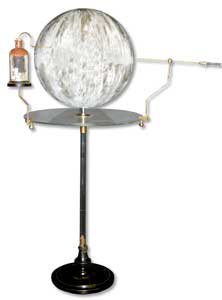
Electrostatic Sphere
Italian
Late 19th Century |

Electrostatic Pendulum
Operates on the same principle as
"Franklin's Bells." |
|
Aepinus Condenser -
1880
 This is an early device used to experiment with the properties of a
condenser (now known as a capacitor.) The Aepinus condenser was the
first condenser developed after the Leyden jar and was used to
demonstrate conductive and inductive electricity. The device is
constructed so that the space between the plates can be adjusted and the
glass dielectric (insulating plate between them) can be removed or
replaced with other materials. This is an early device used to experiment with the properties of a
condenser (now known as a capacitor.) The Aepinus condenser was the
first condenser developed after the Leyden jar and was used to
demonstrate conductive and inductive electricity. The device is
constructed so that the space between the plates can be adjusted and the
glass dielectric (insulating plate between them) can be removed or
replaced with other materials. |
|
| Dischargers Dischargers were used with early friction electrostatic machines to
transfer electricity from the machine to another device such as a Leyden
jar.
|

Henley's Universal
Discharger
|

Large Discharger
1860 |
|

Upright Discharger
1880 |
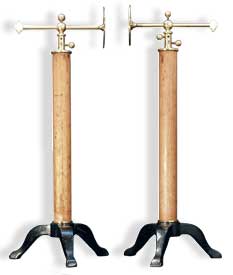
Large Induction
Dischargers
c. 1900 |

Illustration of
discharger in use from 1860 book |
|
  
Glass-handle Dischargers
1884 |
Luminous Frame
 Phrases, and
pictures were constructed on the surface of the glass plate using lead
foil. When voltage was applied from a static machine, the words and
pictures seemed to be displayed in sparks. Phrases, and
pictures were constructed on the surface of the glass plate using lead
foil. When voltage was applied from a static machine, the words and
pictures seemed to be displayed in sparks. |
|
|

Riess Distributing Apparatus
1885 |
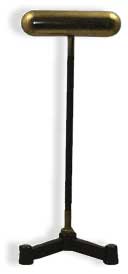
Phillip Harris Company
Insulated Conductor
1885 |
Riess Distributing
Apparatus and Harris Insulated Conductor - 1885
These devices were used in early experiments with electric fields
produced by high voltage friction electrostatic machines. They
were used to demonstrate distribution of charges across the surface of
an object as well as induction - where the charge on one object
creates a charge on another object.
|
|

Field Demonstration Apparatus
1900 |
Max
Kohl Field Demonstration Apparatus - 1900
This apparatus was used to demonstrate distribution of electric fields
on a surface. It consists of a metal screen with paper strips
attached to the surface of the screen (the strips are missing on this
unit.) The screen may be manipulated using two insulated handles. As the
screen is brought together into a closed loop, the paper strips on the
outside surface stand out, while the inside strips do nothing -
demonstrating that charge is carried on the outside of a closed surface. |
|

Early Lightning Rod
(Italian) |

Lightning Rod
(US) |
Lightning Rods
Invented by Benjamin
Franklin, lightning rods were very popular in the 18th and 19th
centuries throughout the US and Europe. See
Thunder House, above, for more
information on lightning rods.
|
|
 Electrostatic Bells
Electrostatic Bells




 Dancing Images
-
1840's
Dancing Images
-
1840's









 Three figures (left to
right) made of hand painted tin with lead weights in base measuring
5-1/4", 5-1/4" and 6-3/8" high. They are beautifully painted, noting
considerable loss of original paint. See pg. 283, fig 318 of Pike's
Catalog Vol I. French; likely last quarter of the 18th Century.
Three figures (left to
right) made of hand painted tin with lead weights in base measuring
5-1/4", 5-1/4" and 6-3/8" high. They are beautifully painted, noting
considerable loss of original paint. See pg. 283, fig 318 of Pike's
Catalog Vol I. French; likely last quarter of the 18th Century.  Box
Containing Electrostatic Philosophical Apparatus - 1st Qtr, 19th
Century
Box
Containing Electrostatic Philosophical Apparatus - 1st Qtr, 19th
Century





 The Electrophorus
The Electrophorus














